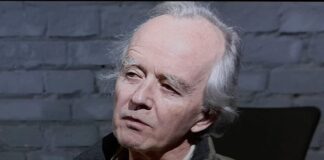For Cerha, orchestras must regain corporeal sounds and emphasize a language of drones of notes, spectral and strong in character, as if to impose themselves on attention. I have repeatedly said that Cerha is the happiest rappresentative of the third dimension of Austrian compositional history, after the classic movement and that of Schoenberg and his associates, although in his case it might be more appropriately called a correction, something that transfers the footprints of Mozart or Beethoven on those of Wagner. It’s the instrumental force of the latter that emerges in the compositional forms, in which percussion takes an important place; this last aspect shows that Cerha has stressed the ties between Wagner and Edgar Varése, offering an efficient combination of both: the aim is to detect the maximum psychological level of the percussive sections. But to be more precise, even Wagner should share a place with the special serialism of Schoenberg, because the instrumental force and lyricism of the first gives way to a large-scale invasion of the motif, that sets up the twelve-tone technique.
These pieces are born in that orbit in a way that we learned to understand over time and that allowed us to update our musical reading, thereby providing an intelligent revision of the past: Nacht perhaps satisfies the sleepless nights of the composer: his interest is in the dynamic of sounds and of the elevation to power of what is heard in the night, when it seems “to belong” us.
Cerha says that the sound-imaginative simulation follows the path of the phenomenon of shooting stars, but in reality the sounds form structures that might encourage other, more earthly sensations: the way in which the strings are used in the opening (cascades of high tonalities) or the vehemence of percussion in the central part are explications of introspection that aim to transfer the mental image to the page, without establishing an unequivocal content (Cerha in the notes clearly invokes the imaginative vision of a night spent looking out the window, directing his hearing toward the surrounding noises). As a container of possible images, Nacht is an invaluable treasure and very Wagnerian after all.
Drei Orchesterstücke emerge from the link with numerology and textures that pays tribute to the hidden truths of the Far East: Tombeau, the final movement of the triptych, is written taking account of magic squares containing 25 numbers, whose distribution and placement is such that there always emerge the same amount, regardless of the direction taken in the counting. In its mysterious charm, one discovers the unique idiom of the instrumental drone that not only responds to the desire to clarify a technique or to highlight the cabal (an aspect that musically should be however investigated), but rather to assess their emotional content.
____________________________________
Le due composizioni orchestrali che reggono questo sospirato nuovo cd del compositore Friedrich Cerha sono intinte nell’astrolabio e nel mistico orientale. Con più dettaglio, in Nacht (terminata nel 2013) e nel trittico legato di Drei Orchesterstucke (tre movimenti composti tra il 2006 e il 2011), il centro di gravità del pensiero del compositore austriaco è rivolto, come al solito, all’assoluto interesse che un fenomeno della vista possa tramutarsi in una tipologia musicale; come già ribadito in altre occasioni Cerha ha un suo marchio distintivo, riscontrabile nella partitura e in quello che ne deriva all’ascolto. Le orchestre per Cerha devono recuperare la corporeità dei suoni e sottolineare spesso un linguaggio di droni di note, dal carattere spettrale e deciso, quasi a voler imporre la propria attenzione. Di Cerha si è più volte detto come egli sia stato il rappresentate più felice della terza dimensione della composizione storica austriaca, dopo quella classica e quella di Schoenberg e soci, sebbene nel suo caso sarebbe forse più opportuno un correttivo che trasferisca le impronte di Mozart o Beethoven su quelle di Wagner. E’ proprio la forza strumentale di quest’ultimo che emerge nella struttura corale, in cui un posto determinante assumono le percussioni; per tale ultimo aspetto Cerha ha esacerbato gli agganci tra Wagner e Edgar Varese, proponendo una combinazione efficiente di entrambi tesa a rilevare il massimo livello psicologico del reparto percussivo. Ma per essere ancora più precisi, anche il Wagner sottolineato dovrebbe condividere la sua posizione con una speciale serie di Schoenberg, poiché la forza strumentale e lirica del primo lascia posto all’invasione a larga scala del motivo, impostato sulla tecnica dodecafonica.







